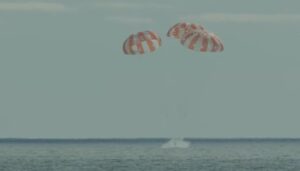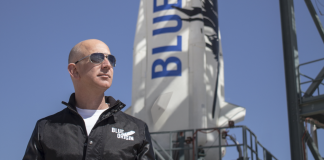DECEMBER 11, 2022

This screen capture from NASA’s livestream on Sunday, Dec. 11, shows an uncrewed Orion capsule splashing down in the Pacific Ocean off the coast of California at 12:40 p.m. ET concluding the Artemis I mission to the moon and back. – NASA
After “skipping” through Earth’s atmosphere blazing in at 25,000 mph, an uncrewed Orion capsule successfully splashed down in the Pacific Ocean on Sunday. Touching down at 12:41 p.m. ET, it marked the exclamation point of NASA’s nearly monthlong Artemis I test flight.
It all started at Kennedy Space Center in Florida with Orion’s dramatic and spectacular night-illuminating launch atop NASA’s 322-foot Space Launch System rocket on Nov. 16.
Sunday’s conclusion came after Orion’s lunar round trip spanning a total of 25½ days and about 1.4 million miles.
Coincidentally, Orion’s splashdown occurred on the 50th anniversary of the touchdown on the moon of NASA’s last lunar mission, Apollo 17, according to NASA spokesperson Rob Navias.
NASA associate administrator, Cathy Koerner, said Sunday from Mission Control Center at Johnson Space Center, “There’s a lot of energy in the room and it’s, it’s very familiar, but it’s also very different as we step into this next episode in human exploration.”
Orion punched through the atmosphere on a complex trajectory called a “skip re-entry” experiencing temperatures of about 5,000 degrees in the process. It then skipped back out of the upper reaches of the atmosphere alleviating some of the heat, speed, and g-forces.
It then plunged back in for the final descent. Traveling at about 300 mph, parachutes deployed to slow the spacecraft’s descent to just 20 mph before splashing down and bobbing in the Pacific Ocean to await its retrieval by the landing and recovery team that was stationed nearby.
Chosen to avoid rough seas and winds associated with a cold front, the landing site off the coast of California near Guadalupe Island off Baja California was predetermined by Air Force weather specialists prior to the departure of the recovery team.
The primary recovery vessel the USS Portland, a U.S. Navy amphibious transport ship, and the landing and recovery team – comprised of about 95 people from the Navy, the U.S. Air Force, NASA, and Lockheed Martin – deployed from San Diego, California, on Wednesday to a holding position in the Pacific.
NASA’s team was preparing the capsule to be hauled aboard the recovery ship.
Just before re-entry, the Orion crew module separated from the service module. It housed its engines and thrusters responsible for maneuvering the craft through space including its Orbital Maneuvering System engine, a piece of repurposed space shuttle hardware, which had previously flown 19 times.
The service module is designed to burn up in the Earth’s atmosphere over a stretch of the Pacific Ocean routinely used for the safe disposal of junk space hardware. According to a NASA blog post, “the Artemis I trajectory is designed to ensure any remaining parts do not pose a hazard to land, people, or shipping lanes.”
Other Orion hardware that was jettisoned during landing, including the forward bay cover and three main parachutes, would be fished from the ocean by members of the recovery team.
Orion’s Artemis I journey
The Artemis I journey to deep space and back pushed Orion’s limits in every way imaginable.
Along the way, the spacecraft even broke decades-long records that were held over from NASA’s Apollo era. Orion flew farther from Earth, punctured through the Earth’s atmosphere faster, and experienced hotter re-entry temperatures than any other spacecraft ever designed for human spaceflight.
The last time a human-rated spacecraft flew anywhere close to Orion’s newly set record of 268,563 miles away from our home planet, was in 1970 during NASA’s Apollo 13 mission.
On Nov. 25, Orion fired up its Orbital Maneuvering System engine to complete a maneuver called the distant retrograde insertion burn. It flung the capsule past the moon into an orbit about 40,000 miles away called a distant retrograde orbit meaning that Orion traveled in the opposite direction of the moon’s orbit around the Earth.
The highly stable orbit was chosen to test Orion’s capability to support future long-duration deep-space Artemis missions that will boast a crew of four astronauts beginning with Artemis II slated to occur in 2024.
Orion’s trek home began Dec. 1, when it departed the distant lunar orbit where it had been for about a week. Then, on Monday, Dec. 5, it made a quick pitstop skirting less than 80 miles above the lunar surface to harness the moon’s gravitational force and fling itself on a trajectory back to Earth.
Zebulon Scoville, NASA flight director, called it “a tip of the hat and a historical nod to the past,” as Orion sailed past the landing sites of the Apollo 12 and 14 missions but was too far away to capture any detailed imagery.
What’s next for NASA’s Artemis?
Unlike the cramped command and service modules of the Apollo era, Orion is designed to host long-duration astronaut missions to the moon and back. NASA hopes to utilize lessons learned during Artemis lunar missions as stepping stones to one day venture even further to Mars.
With the Artemis I mission complete and Orion safely back on Earth, the path is set for NASA to execute a similar mission in the form of Artemis II. Though the mission profile looks similar to Artemis I, it will include astronauts. Orion will also be outfitted with crew seats and life support systems to test out its capability to support long-duration human missions to the moon.
Then, before 2030, Artemis III — a much more complex endeavor involving NASA’s Space Launch System rocket, Orion crew capsule, and SpaceX’s Super Heavy Starship vehicle which is currently still in development — will aim to deliver two astronauts, the first woman and the first person of color, to the lunar surface.
The lucky astronauts who will round out the complement of four have yet to be announced publicly. Whether or not they have been selected and are in training for the mission, is for NASA to know and the rest of the world to find out.
NASA’s Artemis program is designed to enable an extended human presence on the moon. Eventually, the agency hopes to establish a permanent base there supported by a crewed space station that will orbit the moon called Gateway.
One day, NASA plans to use the moon as a pit stop on the way to Mars.

Launch of the maiden voyage of NASA’s Space Launch System rocket. The Artemis I mission launched at 1:47 a.m. Wednesday morning, Nov. 16, 2022, from Kennedy Space Center’s Launch Pad 39B. Launch viewed from Harbortown Marina on Merritt Island. The last quarter of the full moon is visible in the sky.
Courtesy/Source: This article originally appeared on Florida Today / USA Today










































































































